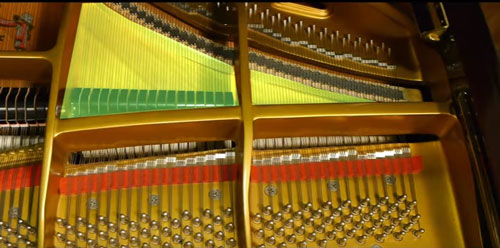Maybe you’ve heard this term before; maybe you haven’t; maybe a salesperson once told you, “You definitely need duplex scaling”. whatever your familiarity with duplex scaling, you will learn something about this technology today.
So what is duplex scaling? Simply put, it’s a tone enhancement system that is used in some pianos to increase tone life. That sounds great, but how does it work?
Every piano has something referred to as the “speaking length” of the string. This is the part of the string that is free to vibrate. In the image below the speaking length is highlighted in yellow:

Typically the area above and below the speaking length of the string is muted out with felt. You can see this area highlighted in yellow in the image below:

Why would this area be muted out with felt? Typically this area of the strings is not capable of adding pleasing harmonics to the sound. Duplex scaling utilizes a technology that tunes the non-speaking length of the strings to enable them to vibrate at musically pleasing frequencies.
Aliquots are used in duplex scaling to precisely terminate the strings at lengths that produce pitches that are complementary to the pitch that is being played. So instead of felt that is used to terminate the string, you have something that looks like this:

On a piano with Duplex scaling you will get the same pitch as all three strings, typically an octave or an octave and a fifth above the notes – which are overtones already contained within the fundamental pitch. The purpose of this system is to enhance the tone by creating more sound from each note.
Most pianos that contain duplex scaling typically feature it on the rear portion of the string. Certain pianos (like the one we are demonstrating in this article) has two sets of duplex scaling in both the rear and the front portion of the strings.

Most pianos use part of the plate above the treble section of the piano (capo d’astro bar) to terminate the strings. On this particular piano, there is a front set of aliquots which allows for the front section of strings to add useful harmonics due to sympathetic vibration, just as depressing the damper pedal adds richness to the tone.
So you’re probably wondering whether or not duplex scaling is something you must have on your piano. While duplex scaling is a useful technology that can enhance the tone of the piano, there are myriad scale design technologies that allow for different tonal results that can be equal in beauty of tone. Duplex scaling is just one way to enhance piano tone.
Thanks again for joining us here at Living Pianos. If you have any questions or comments about this topic or any topic at all please contact us directly Info@LivingPianos.com or (949) 244-3729.


